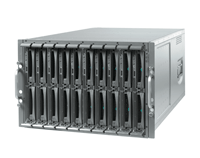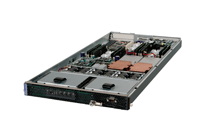The market for blade servers is growing rapidly, especially for new installations, but also for those replacing older server farms. What's surprising is not that blades are soaring in popularity, but why it took so long.Consider the advantages that blade servers have over conventional servers:On one level, a blade server is simply a server like any other and it performs the same tasks. Here's the difference: Instead of having multiple, physically separate servers in a server farm, blade servers begin with one or more sophisticated chassis, each having powerful, redundant power supplies along with other common components.The actual servers, or blades, are plug-in cards containing one or more processors, memory, one or two hard drives and other components'everything, in fact, except the shared hardware supplied by the blade server chassis.A complete blade server includes a minimum of one chassis and one blade, but the chassis is engineered to physically support a multiplicity of blades, each of which plugs into the same chassis.For small operations, one or several individual servers are often the most cost-effective way to support a small network, but in larger installations, particularly ones that are expected to grow quickly in capacity, the blade server architecture is far superior.Since the power supplies and other common components are not duplicated for each blade, this saves space and money. It can also increase reliability and decrease energy consumption'including a reduction in cooling load.In addition to adding more blades as needed until the chassis is full, a user can often upgrade individual blades for many blade servers by adding more RAM, additional processors and larger hard-drive capacity.Given all the options, it might be possible for a single blade-server chassis to be expanded to 20 or even 100 times the original processing capacity without taking up any additional space'simply upgrade blade capacity and increase the number of blades housed in the chassis.The footprint for blade servers varies considerably. The blade-server chassis can be a rackmount or small desktop unit, or it can be a gigantic cabinet capable of housing 100 or more blades, each with multiple processors.Although you may be able to mix blade-server chassis brands on a network, in most instances the individual blades can only go in their own brand of chassis. Blades are not normally interchangeable as are, say, SCSI hard drives or PC expansion cards.A wide variety of CPU chips can be found in server blades depending on the application and processing power required, but many network managers have opted for the familiar x86 architecture, which currently dominates the desktop PC, portable-computer and small-server markets.In fact, many observers feel that Sun Microsystems Inc.'s temporary departure from the blade-server business in mid-2005, when it dropped its Sun Fire line, was due to a miscalculation of the market. Sun based its Sun Fire blades on more sophisticated processors than many users ostensibly wanted in a basic blade server. At the same time, the company failed to provide a sufficiently sophisticated alternative to attract high-end customers, market watchers say. Sun is now offering two blade products in its Netra line of servers.Despite a large and growing demand for blade servers, three makers dominate the market, according to report around the middle of last year by Theregister.com, a British-based IT news organization. IBM Corp. had about 39 percent of the market for blades, with Hewlett-Packard Co. garnering another 35 percent and Dell Inc. following up at the tail end with about 10 percent.There is no particular reason to suspect the numbers have changed significantly since last summer, so the reality is that nearly 85 percent of the blade-server market is concentrated in just three companies. And the two giants with the vast majority of blade sales, IBM and HP, have decades of experience in the enterprise marketplace.Thus, agencies making a large investment in blade servers may have a certain amount of concern about whether any smaller vendor they choose will still be around in five years.[IMGCAP(2)]However, it's reasonably safe to say that many smaller vendors will survive'the blade server market is growing daily so there is room for innovation as long as the smaller players can carve out a niche and can provide sufficient support.This is especially true if small makers serve specific needs beyond those of the major players, such as offering video blade servers, as does Axis Communications Inc. of Chelmsford, Mass., with its Video Server 241q blade, or by producing very high-end systems.On the high end, more products are coming on to the market. Fujitsu Computer Systems Corp., for example, recently announced a new blade that can support four dual Opteron processors (eight processors total per blade). The Quad blade is expected to be available this month.Meanwhile, more technical innovations are on the way. Optional processors for IBM's new blade server line, based on the BladeCenter H chassis, will include not only low-power Intel Xeon processors but blades based on IBM's own Cell processor.Developed with Toshiba and Sony, IBM's Cell Broadband Engine processor (scheduled to be available in blades sometime in the third quarter of 2006) uses a game chip, the one designed for PlayStation 3.A Cell has a PowerPC 970 core with an additional eight numeric/graphics calculators. Cell blades will take up two normal blade spaces and each will include two Cell processors.With the new Cell blades, IBM is targeting medical and other imaging uses as well scientific computing and high-end signal processing.The Cell blades will require a special operating system, a variant of Red Hat's Fedora Linux. Pricing for these Cell-based blades has not been established.Decreased power consumption, and hence lower cooling requirements, is critical in blade server farms.While other vendors appear to be concentrating mostly on increasing the performance of their servers, Intel Corp. is busy introducing new processors that promise a combination of improved performance and lower power consumption.Merom and Conroe chips will decrease power consumption and increase performance for, respectively, notebook and desktop PCs, but of particular interest is the new Woodcrest chip, which is intended for servers.Like the other new chip designs, Woodcrest will use the Intel Core Microarchitecture, which is said by the company to combine the energy efficiency of the Pentium M and Core Duo processors with the high-performance of Pentium 4 and Xenon chips.[IMGCAP(3)]Intel announced the new chips at the March Intel Developer's Forum when the company spokesperson stated that the Woodcrest chips would increase performance by up to 80 percent while reducing power consumption by almost 40 percent when compated with the 2.8-GHz Xeon chip.Look for these new chips to appear in blades before the end of the year, perhaps sooner, with initial sample quantity shipments in the third quarter.
The Fujitsu 10-blade Primergy BX600 sells for $9,000 with 32-bit processors, four per blade maximum.
IBM's eserver BladeCenter JS21 has two dual 2.5-GHz PowerPC 970 MP processors.
THE Express5800 1020Ba blade from NEC Solutions America has 32GB of storage and 2GB of RAM.
- Easy expansion
- Lower cost
- Easier management
- Easier maintenance
- Lower power consumption
- Better utilization of physical space.
Blades' Big ThreeWhat's ahead?In the chipsJohn McCormick is a freelance writer and computer consultant. E-mail him at siliconsamurai@gmail.com.









